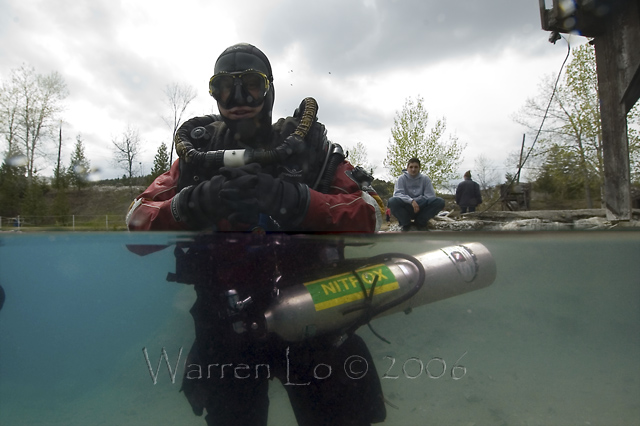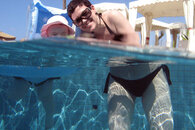You are using an out of date browser. It may not display this or other websites correctly.
You should upgrade or use an alternative browser.
You should upgrade or use an alternative browser.
How to get half topside/half underwater shots?
- Thread starter fairybasslet
- Start date
Please register or login
Welcome to ScubaBoard, the world's largest scuba diving community. Registration is not required to read the forums, but we encourage you to join. Joining has its benefits and enables you to participate in the discussions.
Benefits of registering include
- Ability to post and comment on topics and discussions.
- A Free photo gallery to share your dive photos with the world.
- You can make this box go away
JMD123
Guest
- Messages
- 193
- Reaction score
- 0
Hehehe - nice shot 
I've been trying for years but haven't got one yet that I liked. I did get the effect once but nothing worthwhile as subject
Exposure is definitely the tricky part...


SuPrBuGmAn
Contributor
fairybasslet:OK, but tell me how you got it? Do you have an SLR?
That shot was taken with an Oly C5060 PnS in the Oly housing and its stock small flatport. The next time I shoot one, it'll be from a dSLR
The most important thing is to try to get an interesting view above and below the surface. Most of the shots I see have something good up above, but a lackluster below, or vice versa.
Most digital cameras can retrieve more data from underexposed areas moreso than overexposed areas - opposite of film. So meter for the sky and push the shadows in post processing.
I'd guess the very best solution would be to use a flatport lense with a ND filter over the top half(topside of the shot), or powerfull strobes below.
RonFrank
Contributor
My attempts at over/under shots in the ocean have been failures.
The easiest way to accomplish an over/under is in a well lit shallow swimming pool, or clear calm body of water shooting a single subject, part above part below. This solves some of the exposure, and focus issues that are discussed in the article that joewr posted.
Stephen Frink has some of the most fantastic Over/Under shots I've seen. I'm not sure of his technique.
From a technical perspective, sun behind the photographer, shallow water, good vis, and using the hyperfocal distance in manual focus mode would make sense with maximum DOF based on the available light. Using strobes UW could also help balance exposure.
The techniques discussed using a split ND filter, and split diopter are interesting, but not practical for most UW shooters. Those would require dives dedicated to over/under shots. A perfect spot IMO would be NN Dry Rocks (Keys) on a calm sunny day because the reef is so shallow.
In any event, I'm always impressed with I see Over/Under shots where the sealife is clearly exposed, in focus, and there are is also good DOF, exposure, and sharp focus topside. I will continue to try and get a good Over/Under shot, but not at the expense of a dive. This is definitely something worth tying while snorkeling.
The easiest way to accomplish an over/under is in a well lit shallow swimming pool, or clear calm body of water shooting a single subject, part above part below. This solves some of the exposure, and focus issues that are discussed in the article that joewr posted.
Stephen Frink has some of the most fantastic Over/Under shots I've seen. I'm not sure of his technique.
From a technical perspective, sun behind the photographer, shallow water, good vis, and using the hyperfocal distance in manual focus mode would make sense with maximum DOF based on the available light. Using strobes UW could also help balance exposure.
The techniques discussed using a split ND filter, and split diopter are interesting, but not practical for most UW shooters. Those would require dives dedicated to over/under shots. A perfect spot IMO would be NN Dry Rocks (Keys) on a calm sunny day because the reef is so shallow.
In any event, I'm always impressed with I see Over/Under shots where the sealife is clearly exposed, in focus, and there are is also good DOF, exposure, and sharp focus topside. I will continue to try and get a good Over/Under shot, but not at the expense of a dive. This is definitely something worth tying while snorkeling.
fairybasslet
Contributor
Thanks for the info. I have an Oly 7070. I'll try your metering suggestions next time I have a chance.SuPrBuGmAn:That shot was taken with an Oly C5060 PnS in the Oly housing and its stock small flatport. The next time I shoot one, it'll be from a dSLR
The most important thing is to try to get an interesting view above and below the surface. Most of the shots I see have something good up above, but a lackluster below, or vice versa.
Most digital cameras can retrieve more data from underexposed areas moreso than overexposed areas - opposite of film. So meter for the sky and push the shadows in post processing.
I'd guess the very best solution would be to use a flatport lense with a ND filter over the top half(topside of the shot), or powerfull strobes below.
Similar threads
- Replies
- 6
- Views
- 1,182
- Replies
- 0
- Views
- 116
- Replies
- 8
- Views
- 475
- Replies
- 13
- Views
- 711




